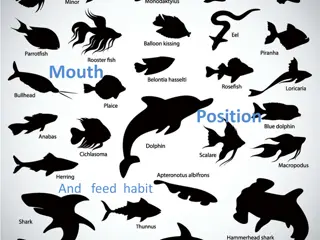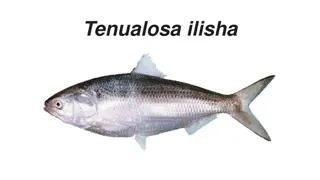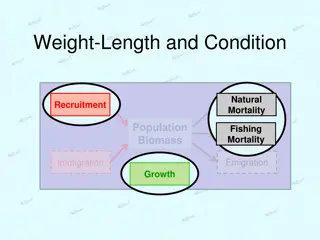Understanding Fish Diseases and Health
Fish diseases and health are essential aspects of aquatic life. Diseases can be infectious or non-infectious, causing impairments to the normal state of fishes. Recognizing symptoms and signs of diseases is crucial for diagnosis and treatment. Overall, maintaining the health of fishes is vital for their well-being and survival.
Download Presentation

Please find below an Image/Link to download the presentation.
The content on the website is provided AS IS for your information and personal use only. It may not be sold, licensed, or shared on other websites without obtaining consent from the author. Download presentation by click this link. If you encounter any issues during the download, it is possible that the publisher has removed the file from their server.
E N D
Presentation Transcript
Health: is a state of complete physical, mental and social well-being and not the absence of disease. Healthy Person: is an individual that can protect all his organs and tissues in an active physiological case against the powers or external or enteral factors that try to blocking it continuously.
A disease is a particular abnormal condition, a disorder of a structure or function, that affects part or all of an organism. The study of disease is called pathology
The term disease is from a French origin (Dis ais) and mean (Discomfort), but its used to determine disease disorders cases. In clinical medicine this term used to showing the way to some Symptoms and Signs. disorders that have
Symptom of disease, while a sign is any objective evidence of disease. is any subjective evidence Therefore, a symptom is a phenomenon that is experienced by the individual affected by the disease, while a sign is a phenomenon that can be detected by someone other than the individual affected by the disease.
Diseases: an impairment of the normal state of the living animal or one of its parts that interrupts or modifies the performance of the vital functions, is typically manifested by distinguishing signs and symptoms, and is a response - to environmental factors (as malnutrition or climate) - to specific infective agents (as worms, bacteria, or viruses) - to genetic anomalies) - or to combinations of these factors.
Types of Diseases 1) infectious microorganisms diseases: due to the action of Can be passed from one fish to another. Caused by germs or pathogens.
Types of Diseases 2) non-infectious: causes (environmental, other) diseases due to non-living Can t be spread from one fish another. Not caused by germs or pathogens.
Type of diseases of fishes Infection diseases 1- Viral diseases. 2- Bacterial diseases. 3- Fungal diseases. 4- Parasites diseases. a- Protozoa (kingdom Protista). The remaining groups are in the kingdom Animalia. b- Monogenea and Aspidocotylea (Phylum Platyhelminthes). c- Trematoda (Phylum Platyhelminthes). d- Cestoda (Phylum Platyhelminthes). e- Nematoda (Phylum Nemathelminthes). f- Acanthocephala (Phylum Acanthocephala). g- Hirudinea (Phylum Annelida). h- Copepoda (Phylum Arthropoda). Non-infection diseases 1- Dietary deficiency. 2- Hereditary diseases. 3- Environmental diseases.
The study of fish diseases and parasites is necessary and important to 1- Increase the production of pond farms. 2- Improve the stocks of valuable commercial fisheries in the natural waters. 3- The possibility of fish adaptation or acclimatization in new sites or localities. 4- Fish parasites can be used as pollution indicators with some heavy metals.
Disease: an abnormal condition of a part, organ, or system of an organism resulting from various causes, such as infection, inflammation, environmental factors, or genetic defect, and characterized by an identifiable group of signs, symptoms or both.
Terminology Epidemiology: occurrence, distribution and types of diseases in populations of animals at distinct periods of time and at particular places (usually refers to humans). Epizootiology: same as above (non-human) epidemiology is the study of the who, what, when, where, how and why of disease outbreaks. branch of medicine describing
Zoonoses (singular zoonosis): are infectious diseases of animals (usually vertebrates), that can naturally be transmitted to humans. Common diseases between human and animals. Anthroponosis: is a term applied to infection with parasitic species infecting human only. Anthrozooponosis: is an infectious disease in which a disease causing agent carried by humans is transferred to other animals. Zooanthroponosis: is a term referred to infections in which human is not the principle host, but is an essential link in the life cycle of the parasite. The transmission of disease from animals to humans.
Infection It so- called to refer to the case of exposition to the ecto or endo parasites (agent), but most of American scientists say this word to refer to the internal infections only, and sue the term infestation to refer to the external parasites (agent) infestation.
Epidemiological triad Infection process Agent Host Disease Environment
Host factors 1- Resistance and immunity factors 2- Genetic factors 3- Physiological factors 4- Age factors 5- Sex factors 6- Socio-cultural and habitual factors
Agent factors 1- Type of agent (Agents causing disease) 2- Number of agent (Dosage of infection) 3- Spore formation 4- Viability 5- Host specificity 6- Antagonism 7- Pathogenicity 8- Toxicity 9- Tissue selectivity
Environmental factors 1- Physical environment Geographical, geological and climatic factors 2- Biologic environment 3- Socio- cultural environment 4- Economic environment
Prevalence of infection (rate, incidence): the percentage of number of individual of a host species infected with particular parasite species per number of host examined. Prevalence: the expression of the frequency of a disease at a particular point in time in relation to the population in which it occurs (%) proportion: number affected/population Mortality: the percentage expression of the frequency of deaths over a period of time in the total population (not a rate, a proportion)
Degree of Infection Acute disease: high degree of mortality in short period of time, external signs might be completely lacking. Chronic disease: disease that is a long-term issue, gradual mortality, difficult to detect a peak. Latent disease: disease agent present, but host shows no outward sign, little or no mortality, sometimes associated with secondary pathogen/ infection. Incurable disease: disease that cannot be cured. Terminal disease: disease with death as an inevitable result























